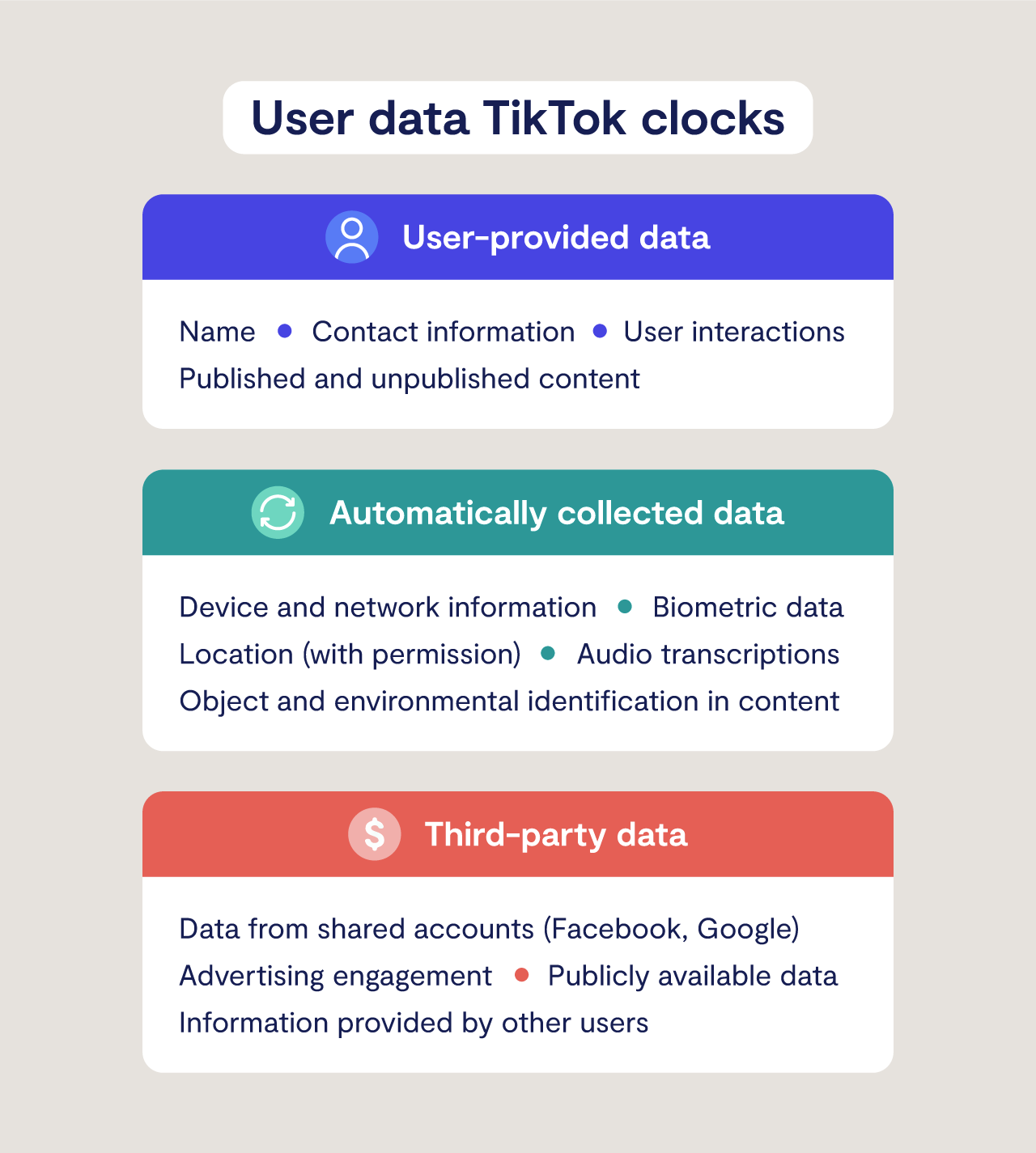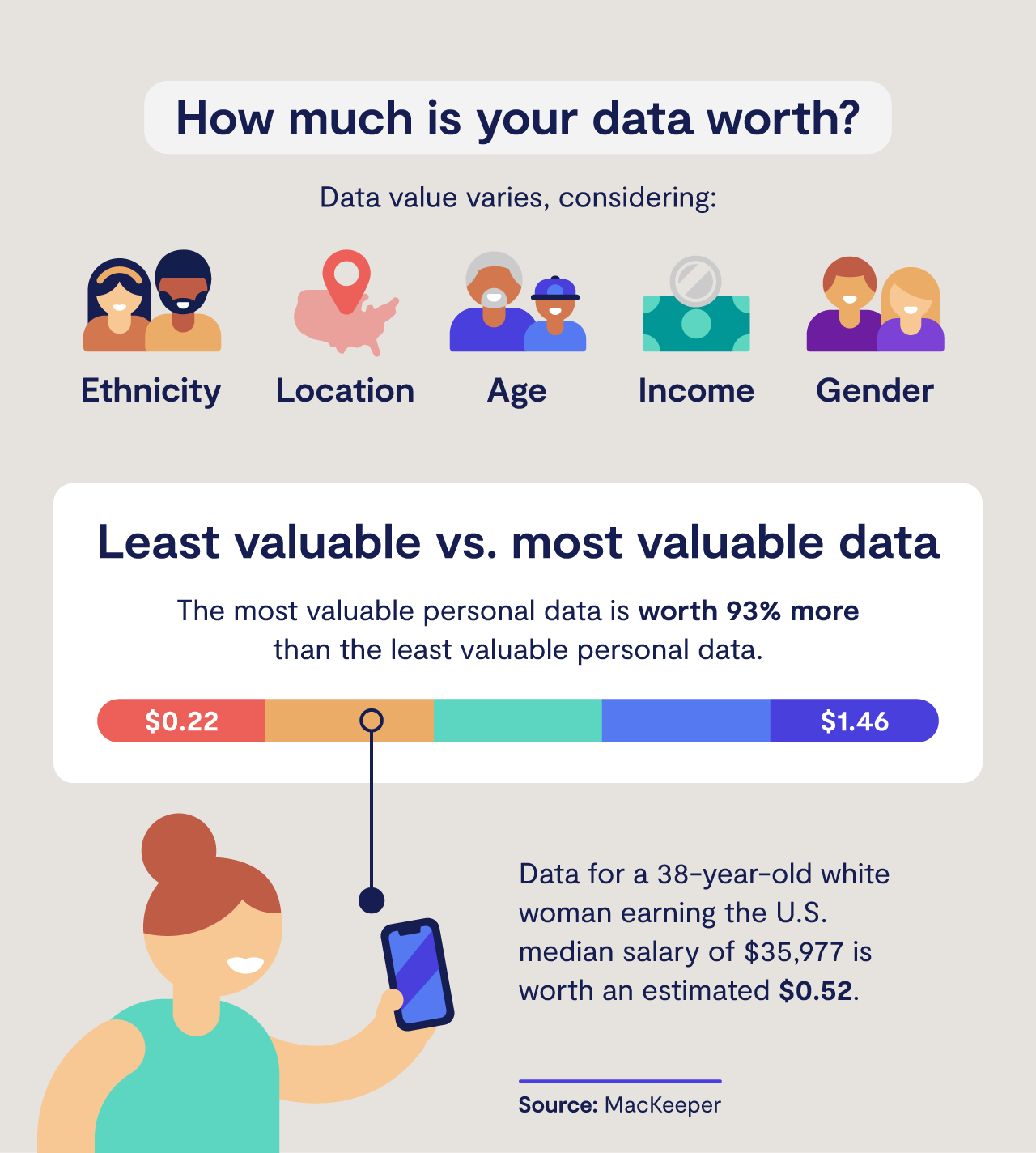TikTok Data Collection: What It Knows and Shares About Users
TikTok, the video-based app formerly known as Musical.ly, has erupted in popularity over the last few years and currently boasts over 136 million users in the U.S. alone. This free app allows users to join choreographed dance trends, keep up on pop culture news, and reimagine viral comedy bits.
Of course, nothing is truly free in the digital age. In exchange for hours of entertainment, users supply TikTok with data about their behaviors, interests, and identity. This valuable data helps TikTok improve its service and keep the lights on by attracting big-ticket advertisers.
While every app on your phone collects user data and uses it in a variety of ways, TikTok’s relatively recent success, seemingly psychic algorithm, and roots outside of the U.S. have created some concern about TikTok privacy issues and who has access to user data. It’s especially concerning considering 70 percent of users spend over an hour a day in the app.
We’ve dug into TikTok’s privacy policy and compared it to other popular social media apps to see how much TikTok knows about its users and how you can defend your data.
Key Findings:
- TikTok collects a significant amount of data on its users, but not as much as competitors like Meta.
- TikTok doesn’t sell user data, but does share it with third-party partners and advertisers.
- TikTok has access to a significant amount of environmental data, which it automatically parses for biometric, visual, and audio cues.
What data does TikTok have on its users?
TikTok collects a significant amount of user data, from account information to unpublished comments on other users’ videos. TikTok’s privacy policy organizes user data into three categories:
- User-provided data
- Automatically collected data
- Third-party data
User-provided data and automatically collected data are sourced from the user’s actions on the platform. Third-party data is provided by TikTok partners or other users — not from app use itself.

User-provided data
User-provided data includes any information voluntarily provided to the app when an account is created. This includes identifying information like your name and email address, your profile information, and any data you create through the app’s use on your phone or browser.
User-generated content collected by TikTok includes everything you do on the platform, whether you publish it or not. It tracks comments, direct messages, livestreams, uploads, and drafts. This information collectively provides audio, visual, and written data for TikTok to save and analyze.
Automatically collected data
Automatically collected data includes technical information like your connected devices, IP address, and location (with permission). This information is commonly collected across apps and websites to improve localization and functionality.
TikTok also generates data automatically by parsing through user-generated content. This means any video or image made or uploaded to the platform (even if it was never published) provides audio and visual data for TikTok to analyze, including:
- Biometric faceprints and voiceprints (as permitted by law)
- Face and body features within imagery
- Text transcripts of spoken audio
- Identifying objects and environments
TikTok does clarify that this data is used for non-personally identifiable information (non-PII), which means it can’t be used to trace or identify a person on its own. Instead, TikTok uses this data to:
- Recommend content and advertisements
- Provide special effects and filters
- Moderate content
- Classify demographic information
Within this category of data collection, TikTok also has access to your messages — composed, sent, and received — and cookies that track your behavior on and off the platform. While this sounds concerning, cookies are pretty common across the web and can often be managed through browser or website settings.
Third-party data
Third-party data providers include other social media sites you log in to, services TikTok partners with, like advertisers or analytics tools, and other users themselves.
If you created your account with your Facebook login, Facebook and TikTok share your data with each other. This includes your contacts and behaviors on each platform — doubling the information they have about you and your digital social circle.
Third-party providers also include parties TikTok has partnered with that aren’t necessarily disclosed to the user. This means advertisers may have access to your data to purchase targeted advertisements, and how you interact with the ads through clicks, watches, or other behavior is tracked and can be shared with TikTok and its advertisers.
Finally, TikTok can pull any publicly available data on you and information provided by other users. So if a user reports your content or mentions you in customer service communications, TikTok collects and assigns that data to you.
Data and users under 13
Users under 13 have different data permissions than teen and adult users. TikTok only collects account information provided by the user, including their username, password, and birthday. Device and network information, as well as in-app usage data, may also be recorded.
To protect young users, in-app actions are also extremely limited. Users under 13 aren’t permitted to post their own content or message other users. They can create videos using app features such as audio clips and filters, but this content can only be downloaded directly to their device and TikTok doesn’t collect or analyze data from these files.
TikTok partners and your data
TikTok doesn’t sell personal information to third parties, but there are a number of partners and situations that have access to user data, including:
- Service providers
- Business partners
- ByteDance corporate groups
- Business transfers (e.g., in the event of bankruptcy)
- Third-party sites (with consent)
- Legal requests (government inquiries, court orders, etc.)
Mostly, user data is shared to benefit business operations, from user analytics and database maintenance to advertising and marketing services. This aligns with Google and Apple privacy policies that prohibit the transfer of user data (sold or otherwise) to third-party companies that aren’t improving the app or displaying in-app ads.

The kind of data each partner has access to varies by their specific service:
- Payment and transaction services: access to all data, excluding messaging insights
- Customer and technical support: access to all data
- Research providers: access to all data, excluding messaging and payment information
- Cloud services: access to all data
- Advertising, marketing, and analytics vendors: access to all data, excluding messaging and payment information
Advertising and marketing vendors may be the most concerning for many users, as TikTok shares this data to improve its targeted advertising. User profiles are provided for advertisers to choose among audiences with specific behaviors or interests they’re trying to reach.
Users that appreciate personalized ads benefit, though a growing number of consumers believe personalized advertising and news feeds on social media are unethical, especially considering the threat of hackers jeopardizing your mobile security and the massive amount of sensitive data sites like TikTok hold.
Why does TikTok collect user data?
User data is hugely valuable for platforms looking to improve user experience. It shows TikTok what users are interested in and how they interact with content, which helps developers improve the search algorithm and site features.
Improved in-app experiences and tailored content often translate to increased engagement and use of the platform. Increased users and user interest also spread through word of mouth and improve adoption rates.
A growing and happy audience boosts advertiser interest and costs, driving advertising dollars. Data also allows advertisers to target the exact audiences they believe they’re most likely to convert — which is a major bonus non-digital services can’t offer with as much certainty.
At the end of the day, your data helps TikTok improve its product, drive user growth and retention, and increase profits. While the app may not explicitly sell your data, TikTok and almost every other app on your phone have found ways to profit off it.

What makes TikTok stand out from other platforms is the depth of data it has access to.
As mentioned above, TikTok doesn't just store your content on a server in some desert warehouse. It analyzes user content to pull insights beyond what’s provided during account creation and through in-app behaviors.
Video content is so engaging because of how much context it provides the viewer. That’s what makes TikTok so popular, and what makes it a data powerhouse. Its analysis pulls biometric data, environments, audio transcriptions, and visual cues that a static image on Instagram or a quick Tweet doesn’t capture.
How TikTok compares to other apps
TikTok is one of hundreds of apps that collect your personal and behavioral data across the web. Most services store your name and email address, and many collect third-party data through cookies and partner logins.
Some dig a little deeper to track biometrics for face recognition or in-app filters, and even maintain access to your camera as a background process. Here’s a look at the types of data the five most popular social media apps are collecting:

The biggest difference between TikTok and other social media is how TikTok tracks your unpublished content, including videos and comments. Biometrics like audio data and facial recognition are less common than cookies, but major players like Meta (which owns Facebook and Instagram) and Google (which owns YouTube) also store this information.
Tips to improve your privacy
You have a right to privacy — even in the digital age where we’ve normalized invasive ads that seem to know the exact topic of conversation over dinner the night before. And you don’t need to throw your phone off a bridge to protect your digital privacy.
Here are some simple steps you can take to restrict what data is available and how it’s shared when surfing the social web:
- Turn off personalized ads
- Use a virtual private network (VPN)
- Don’t log in by connecting to other social media accounts
- Restrict contact and location permissions
- Create a “burner” email for social media
- Disable cookies
- Manage third-party advertising permissions
If you’re curious about what information a platform has about you, you can typically request user data directly from the company. You can also limit third-party data collection and opt out of cookie collection.
Our digital lives play an increasingly important role in our personal relationships, career, and overall well-being. While you may not be able to (or want to) eliminate your digital footprint, you still have a right to privacy.
Sites like TikTok don’t steal data or sell it, but they do maintain and share data access. Understanding how major platforms on devices collect, use, and share your data for profit allows you to reconsider who you want to give data access to and how you can limit your cybersecurity risks.
Stay smart about the apps you download and dig into account settings to limit data collection and distribution. Take time to read a platform’s privacy policy before you agree and explore available anti-tracking tools to protect your data.
Important note
Learn how cookies collect and distribute data in our INFOGRAPHICS.


